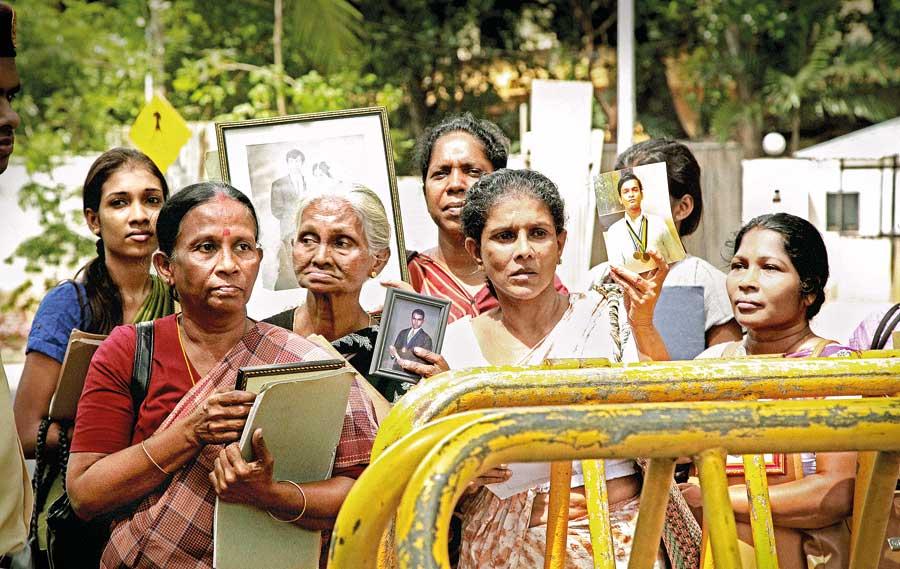04 Sep 2020 - {{hitsCtrl.values.hits}}

A scene from the film ‘paangshu’
- Once bodies are buried underground you do not know what happens to them
- There was partial justice, but not full justice. There was only reparation, but no punishments
- We are more tribal than feudal as a society. We keep re-electing family members
- We are lacking the rule-of-law because the law is not equally applied to every citizen of this country
- Vengeance may also be drawn simply because individuals are members of a particular community
Human rights issues related to enforced disappearances in Sri Lanka still continue. The grievances and the anxieties of those loved ones of the disappeared due to the ‘88-89  insurgency and the three-decade-long separatist war exist to this day. In this context Daily Mirror spoke to human rights activist and award-winning filmmaker Dr Visakesa Chandrasekaram to discuss his latest film ‘Paangshu’ and the wider issue of disappearances and the justice system in Sri Lanka.
insurgency and the three-decade-long separatist war exist to this day. In this context Daily Mirror spoke to human rights activist and award-winning filmmaker Dr Visakesa Chandrasekaram to discuss his latest film ‘Paangshu’ and the wider issue of disappearances and the justice system in Sri Lanka.
Excerpts:
 Q What inspired you to make this movie?
Q What inspired you to make this movie?
It’s a play script and was written originally eleven years ago. I wrote it for a friend of mine but she didn’t want to produce it. After that, I left it aside and I wrote a new screenplay based on that story. Besides the original play script was very different. What is the obligation of people like us, the activists or artistes? We have the capacity to produce art and have the capacity to engage in political discourse. The plot comes from the Suriyakanda mass disappearance. About thirty schoolboys were taken away. They were abducted and never found. I think some of their bodies were identified. Those days I remember seeing a couple of photographs. One was a mother looking at a tray of some exhumed body parts on a table. They were basically bones. It looked like she had come to identify them. I remember another photograph where a young man who must have been a sibling of the disappeared one, holding the bones and weeping near a grave. These were the main reasons or inspiration for the story.
Q What is the significance of the film title ‘Paangshu”?
It is symbolic partially. It has a political as well as spiritual underpinning. In terms of political symbolism, it signifies secrets. Once bodies are buried underground you do not know what happens to them. It is going to remain eternally secret, unless and until somebody actually breaks the code of silence. So there is an idea of political secrecy and a political code of silence. That is the political symbolism.
With regard to spiritual symbolism, the idea comes from the ‘Paangshu Koolaya’ in the Buddhist ideology. Paangshu Koolaya is the piece of clothing given to Buddhist monks. But originally it was meant as a piece of cloth that was used for wrapping dead bodies. Monks were supposed to go and collect them and colour, stitch, cut and wear them. You abandon all desires and all physical things and even basic clothing. It signifies abandonment. Those are the two symbols signified by the name.
"Those who are still enjoying the euphoria of the war victory are not interested in acknowledging what the military has done to Tamils"
Q According to Amnesty International, Sri Lanka has one of the world’s highest number of disappearances, with 60,000 to 100,000 people vanishing since the late 1980s. So far no one has been held accountable for these enforced disappearances. How important is the film in such a context?
These are numbers in reports. These numbers are viewed through the coloured glass of individuals who are part of a political ethnic group or a particular political group. Tamils generally do not want to acknowledge what the LTTE has done to the Sinhalese. On the other hand, on the Sinhalese side, those who are still enjoying the euphoria of the war victory are not interested in acknowledging what the military has done to Tamils. There is one thing we as artistes can do. That is to put the numbers aside. The numbers only come in the movie at the end. But until then what you see is feelings, human emotions, human suffering and intermittent happiness. I think that’s what we can do as artistes. Just to share with people what lies behind those numbers and behind those reports. I think for a moment somebody who watches this movie will have to remove those coloured glasses, because they are no longer looking at statistics but at people. The direct result is to just understand the suffering of individual humans behind these atrocities.
Q You have shown certain attempts by various governments to investigate and bring justice to these disappearances. What is your view about the processes?
I think overall they have failed. There are certain instances like setting up the Office for Missing Persons in 2016. That is a little solace for those people who are still waiting for their loved ones to come back. Some of those commissions have issued certificates saying this person is missing, and sometimes they have issued death certificates and given compensation. So in that context, there is at least some sort of closure, because certificates say this person no longer exists. But I don’t know whether you can call it a success. There was partial justice, but not full justice. There was only reparation, but no punishments. I have a lot of issues about the whole model of justice that is affiliated with the idea of punishment. I don’t know whether that is the only way to look at this whole issue. But I think overall we as a nation have failed to deliver justice to those disappeared people as well as their loved ones who are remaining and waiting for their return.
|
Photo credit Praveen Mirando |
Q You have subtly criticised the legal system of the country in the film. What changes should the legal system have to ensure justice is served to those directly affected?
I think my criticism is more than subtle. As a simple fact, the movie shows how dilapidated courthouses are and how little is being invested in the justice system. The court scenes in the movie depict 1995, but those days politicians had fancy cars and air-conditioned rooms. Still, rural courthouses were like that. That is a strong criticism.
I think we are more feudal than democratic as a society. We are more tribal than feudal as a society. We keep re-electing family members of dead politicians. That means we are still strongly influenced by those feudal and tribal relationships. My main criticism is about the existing system. We have a system of going from one court to another, with a number of layers of appeal options. We have non-judicial tribunals like the administrative review tribunal. We have a good framework on which we can really improve the system. But the main issue is we are lacking the rule-of-law because the law is not equally applied to every citizen of this country. That is the main issue. It is applied in a particular way to the less-privileged and poor and destitute people and it is applied in another way to rich, privileged and influential people. What we should do is, first of all, is to establish the rule-of-law.
Q Successive governments were expected to ensure justice. But when they come to power they have failed to do so. Why is this?
I think these are tribal, feudal societies. In such a society there is a belief that one is born to be controlled and ruled. So there is a belief that one brings birthrights and privileges over the other person. That is what happens to politicians. The moment they get into power they behave like tribal leaders. But I think, from a practical point, the issue is we have created a political system that provides enough room for individuals to earn money and not serve the public. The main turning point was the 1978 Constitution which introduced the Presidential system. The 1978 Constitution introduced features which are detrimental to the functioning of democracy, like the Executive Presidency which is not responsible to anybody. The four major changes that occurred with the 1978 Constitution were the Executive Presidency, the proportional electoral system, losing or destroying the independence of the public service and influencing the independence of the judiciary. I think overall all these changes have contributed to the lack of power as a society—our lack of ability to ensure justice. In a democratic society access to justice should be equal.
Q According to you both victim and perpetrator ultimately become victims. How would you expand on this within the Sri Lankan context?
The separatist armed movement had already started in the 1970s after the killing of Alfred Duraiappah. Within that separatist armed movement we had a Tamil rebellion as well as a Sinhala rebellion. One of the features of this conflict was that nobody from outside came to kill us, except for the short period of two to three years of the Indian Army’s occupancy. Apart from that, everything was done by our people to our people. That’s why I ask, who is the victim? Who is the perpetrator? Whoever did that, they were our people. And whoever was being killed by them were also our people. From that context, victims and perpetrators are our people. That was one reason I wanted to make this film.
Q When looking at disappearances in Sri Lanka, it has been used as a means to suppress, harass and intimidate various parties. Your comments?
It is certainly a political strategy. There are a lot of strategic applications of it. Those who do it expect a lot of results. The number one result is to get rid of the enemy. But if you look at the scale of disappearances, they are not always targetted. Targetted disappearances are I think very small, like the disappearance of Prageeth Eknaligoda. In numbers, they were very little. But I think the perpetrators were expecting to give a very strong message of demanding submission, of not only their enemies but those who are likely to become enemies. It is a kind of performance. Through that performance, a clear message is given. That is, “Don’t meddle with us. Do you want this happen to you?” That is the main application of disappearance, rather than targetting. Another type is actually some sort of vengeance. So it could come in two ways. One is that a particular individual actually could have taken weapons against one party, as the LTTE. Once weapons are picked up and used to fight against the military or visa versa, you become an enemy. They then claim the legitimate right to kill that enemy. But sometimes they are not armed people. They are civilians. The LTTE killed devotees who came to the Sri Maha Bodhiya. The military has done something similar to the Kokkadicholai massacre. They were civilians. Vengeance may also be drawn simply because individuals are members of a particular community and not because they have done something wrong, and so they are punished.
"One of the features of this conflict was that nobody from outside came to kill us, except for the short period of two to three years of the Indian Army’s occupancy"
Q With reference to disappearances, where does Sri Lanka stand?
I haven’t heard of good examples of handling these things in a positive way. There could be some isolated incidents of some justice being done. But we are talking mass-scale. For example in Cambodia one-fourth of the population died in the civil conflict, and they ended up going for an international criminal tribunal. Through that, some sort of justice was delivered, but not necessarily only for those who had disappeared. In South Africa, they introduced truth and justice commissions, and they set it up locally. It worked there because those who were mainly oppressed were the majority, and they had come into power. So they could actually dictate the terms of the system. That is a model that was somewhat successfully implemented in South Africa, which I believe gave an opportunity for the loved ones of the disappeared people to come and seek justice. That’s an alternative model. It is an alternative model outside the British colonial justice system given to South Africa. I don’t think we were able to really point out to initiatives in this context.
Q Almost every decade from the 1950s up to 2010 disappearances have taken place in different forms. Do you think we might have to talk about disappearances in the future too?
Now we are caught between a power struggle with China and India. Whatever we do, there will be international actors which we can’t ignore. The interests of these international actors and power players have somewhat changed. Because of that, whatever will happen next, may not be the same. But it could be even brutal on one line. The reason I am saying this is the whole socialist and capitalist camps have fallen, and in the post-cold war, new powers are emerging. It probably won’t be in the best interest of these power players to see another conflict in Sri Lanka. The war is most likely going to be played in the digital battleground. The creation of heroes and enemies will happen in the digital space. Rebels will be fighting in the digital space and will be killed in the digital space. Already we have started seeing things like this. Reporting on Facebook can suspend a particular account for 30 days. That implies that one’s outlet to express oneself is going to be shut down. That is the new war. Our existence is very precarious because we simply exist because of the digital space.
Q Mahinda Rajapaksa’s ‘Paada Yaathra’ in 1992 campaigned to pressure the UNP regime to investigate enforced disappearances during the JVP insurgency. But when Mahinda Rajapaksa became President he showed no interest in investigating enforced disappearances. Why is this?
As an individual Mahinda Rajapaksa was looking for a path for power. At that particular occasion, it made sense for him to take files full of missing persons’ details and go to Geneva. There was no genuineness in what he did. If he had been genuine we would have seen his continuous support. At that particular point, it was his interest to join the public who were demanding justice for missing persons. But at this particular point those people who went on the Paada Yaathra have given up. It’s a closed chapter in their lives. They have forgotten. Some of them might have been paid compensation, and some of might have thought they are going to move on, as this is enough. The other thing is, it is now in his best interest to nurture the Sinhalese Buddhist political ideology that he and his partners have created. That cannot be sustained if he is going to support the Office of Missing Persons because most missing persons are Tamils, not Sinhalese. So it goes back to the concept of the ethnically polarised glasses he is wearing. He cannot see that. Even if can see it, he cannot do anything because his constituency will be against it.
10 Jan 2025 5 minute ago
10 Jan 2025 12 minute ago
10 Jan 2025 28 minute ago
10 Jan 2025 43 minute ago
10 Jan 2025 48 minute ago